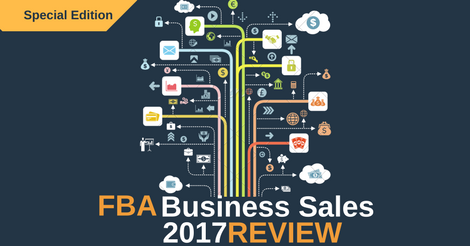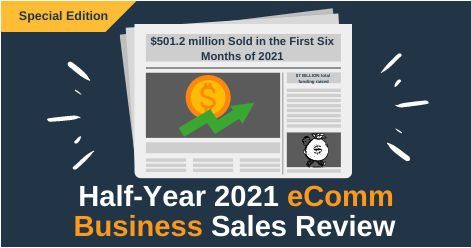Update: Our 2018 Year in Review is now available.
What a year 2017 was for Amazon FBA Businesses!
We tracked 174 FBA businesses reported as sold which equates to $329 Million in List Price value.
Within this review, we’ll break down the Sold Listings, List Prices, Days on Market, Top Amazon Categories, List Price Multiples, and much more. The FBA Business market was HOT this year compared to 2016 with a 400% increase year-over-year of sold businesses.
We’re excited to share with you our insights and show you the findings from the data after tracking the market for more than a year.

First, please read this quick note about how this report data is put together. We search for ALL listings available online and compile the data. We are limited to publicly available data and rely on brokers and websites to update when listings are sold, the current price and other details. At this time there is no central repository of sold businesses.
Note: Where it’s relevant we refer to market pulse data by the International Business Brokers Association (IBBA). Their data is sourced from IBBA and M&A Source members who participate in quarterly surveys. Further details and reports can be found here: IBBA Industry Research.
2017 – the numbers!
In 2017 we tracked a total of 565 FBA businesses listed for sale. This consists of 86 listings carried over from 2016 which were still active, plus 479 new FBA listings we found during the year.
Here’s how 2017 closed out.
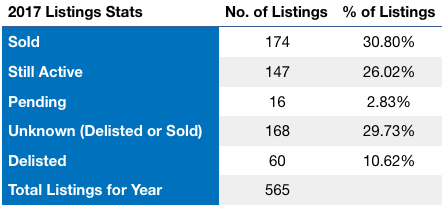
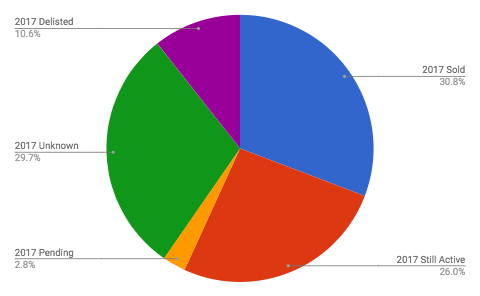
Almost 30% of listings were removed from the marketplace without any available information as to their final status, therefore these business may have been sold or delisted. However we suspect that the majority of these listings were likely sold based on the strong sell through rate of other FBA businesses during the year.
Below is a breakdown of all sold FBA Business listings based on the list price. This tells us a lot about the sellers and the potential buyers in the market. Over 60% of the listings were under $500,000 which is a huge portion of the market and this attracts a certain type of buyer but more on that later.
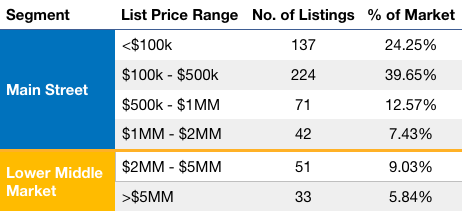
Additionally, we can see trends emerging by breaking up the data into calendar months. There was a huge influx of new listings in January, followed by a spike in sold businesses around April. And as the market got saturated with listings during the middle of the year we see the delisted numbers rise continuously through to December.
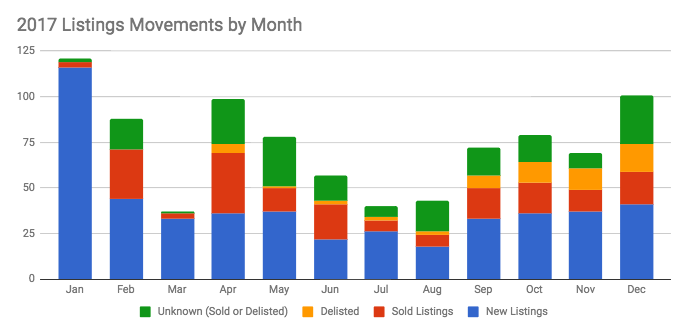
Sold FBA Business Listings Data
Most notably the sheer volume of listings that came onto the market and sold (174) this year compared to 2016 (in which we only found 43) was huge! To put that into perspective that’s over a 400% increase year-over-year.
During 2017 we tracked 174 FBA businesses reported as sold which equates to $329 Million in List Price value. That’s a lot of money changing hands from buyers to sellers.
Taking a closer look at the sales per quarter we can see 2 things:
- Quarter 2 accounted for 37% of sold listings for the year.
- As more listings become available the Days on Market increased.

There is certainly a correlation between the amount of sold listing earlier in the year impacting the days on market in the later half. It went from a seller’s market in Q1 & Q2 to a buyers market in Q3 & Q4.
As savvy buyers rushed to snap up the best deals from all those new January listings, their capital decreased leaving fewer buyers and too many sellers, turning the tables on the market demand. This allowed buyers to take their time in choosing the right business to purchase. Additionally, the IBBA reports that “savvy buyers are used to doing larger deals, but they are continuing to use their rigorous due diligence process on smaller companies”.
If we look at the sold listing by segment we can see that the largest businesses, those with a list price over $5MM had the best sell-through rate (51%).
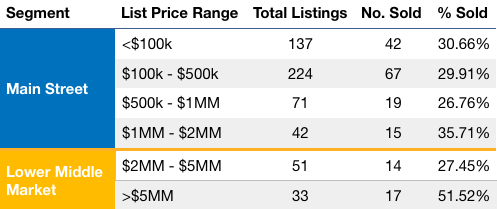
It’s no surprise to us to see that the lowest percentage of sold listings is in the $500k-$1MM range. Most buyers at this range want to use debt, such as an SBA-backed loan, to purchase the business. However many FBA Sellers don’t have the necessary requirements to make their business eligible for this type of loan, leaving only potential cash buyers. This dramatically reduces the buyer pool meaning listings in this range can take longer to sell. (See Days on Market for more details).
For US-based companies, there is some good news as the SBA loans requirements change from a minimum down payment of 25% to just 10%. The makes finance a favorable option for buyers and therefore it’s driving sales numbers.
Final List Price
During the year we track many changes to individual list prices and in some cases, we see a 50% drop in price before a business sells. As there is no central repository for sold online businesses we will often never know the actual sold value of an FBA business.
However, if we look at the IBBA’s data from Q3 we can see that only the businesses within the $2MM-$5MM sell at their asking price. Whereas with $1MM-$2MM listings, it’s less than 90% of the asking price.
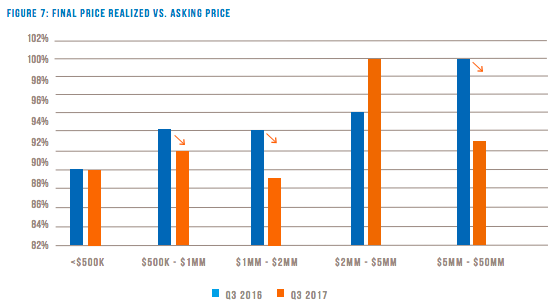 Source: IBBA Q3 Report
Source: IBBA Q3 Report
There was a slight shift however in Q4 where we saw the sub $500k listing go over asking. The BizBuySell Insights Report states “the median sale price of sold businesses in Q4 jumped nearly 12 percent from $206,000 to $230,000. The median sale price rising faster than the asking prices could point to more established buyers willing to pay more healthy listings.”
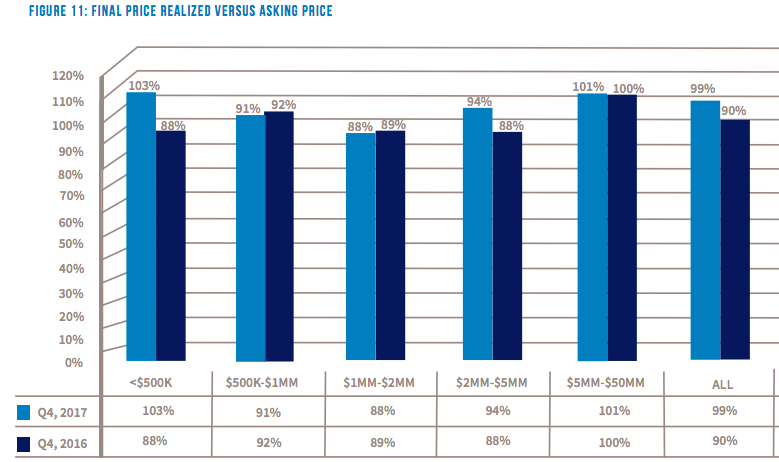
Source: IBBA Q4 Report
Largest Sold Listing
A $55MM Health & Beauty FBA business takes the honor of the largest FBA Business known to have sold in 2017. It also takes the award for the highest list price multiple of 5.23x, but surprisingly it was snapped up within 122 days on the market.
We are seeing increasing demand on the buy-side from private equity funds and higher-level investors who want a piece of this booming eCommerce model. We’re predicting that this will only continue to increase in 2018.
Days on Market
In Q4 we saw Flippa (an online auction site) open their Amazon FBA section allowing Sellers to represent themselves to sell their FBA business via an online auction. This dramatically reduced the days on market for the <$100k listings. Whereas with the >$5MM FBA deals, they take the longest to close which is in line with the greater business sales market. The Q4 IBBA report found an increased time to close stating “The due diligence process is taking longer as we see more private equity groups move downstream.”
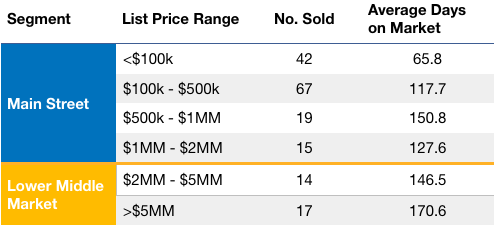
We also know from IBBA data that the different price segments have different funding sources (see below) which also impacts the average days on market. As mentioned earlier the $500k-$1MM has the lowest sell-through rate, and it also has one of the longest days on market (average 150 days). Typically we see buyers who want to use less cash, and more debt in this segment. If businesses aren’t eligible for financing (and we find this segment to be the case) then it takes much longer to find a cash buyer for these listings.

Source: IBBA Q4 Report
Days on Market for Active Listings
At the beginning 2018 the marketplace had 147 active listings. Of these 50% have been on the market for less than 90 days, whereas 32% of listings have been sitting for over 6 months. Just like any industry, real estate, brick & mortar retail, or eCommerce, there are good deals and bad. Some sellers want out, but their business just doesn’t appeal to the buyers in the market. FBA businesses are no different and this means that a savvy buyer could potentially seize a deal from a desperate seller.

Top Amazon Categories
To determine this most sort after FBA Businesses we’ve tabled the top 6 Amazon Categories from the sold listing only. This is a simple count of listings by category. It does not reflect the value of these listings vs their category.
Percentage of Sold Listings by Category
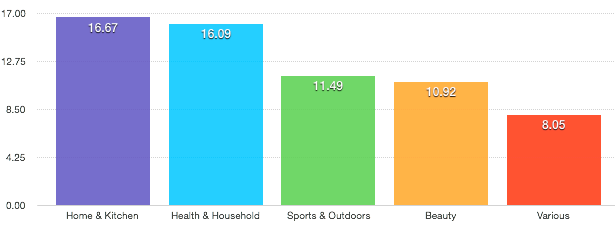
Home & Kitchen took to the top spot with 16.67% of sales, for the most sold listings in 2017 closely followed by Health & Household (16.09%). Interestingly 75% of the Health & Household sold listings we Supplement focused businesses which shows a strong demand by buyers of this subcategory.
Reviewing the top categories by market segment didn’t reveal much. The most noticeable change here is that Health & Household is more prominent in the Lower Middle Market (above $2MM).
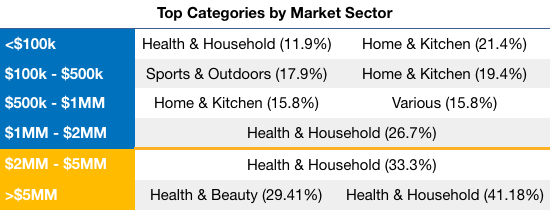
List Price Multiple Factors
During a presentation in Thailand last October we spoke about the 2018 trends we see for the industry as well as the factors which impact a seller’s potential list price. If you haven’t seen it you can watch a recording below.
Now that we have wrapped up 2017 we can see if those predictions for list price were correct. Here are the factors which most brokers and buyers will take into account when analyzing an FBA business:
- Net Profit
- Business Sales Channels
- Product Types
- Amazon Categories
- Amazon Marketplaces
Having multiple sales channels always results in a higher list price multiple, regardless of size. However, when it comes to Private Label (PL) verse Proprietary products it becomes less important above a $500k list price. This may be because there are simply more PL businesses for sale than those with proprietary products. Or because a larger business is more stable regardless of its product type.

Buyers for FBA Businesses
Utilizing the IBBA data we can confirm what we see in the market every day. The lower end of the market is still dominated by individual buyers, whereas the higher end sees a larger portion of existing businesses or PE firms coming into the market.
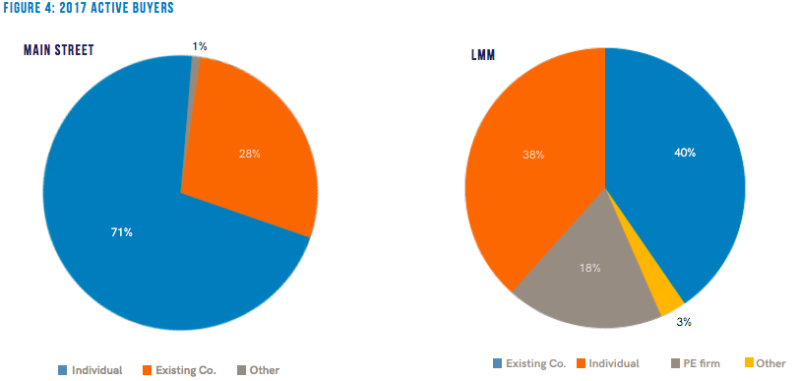
Source: IBBA Q4 Report
That’s a wrap for our 2017 FBA Business Sales Report. This next year is already showing signs of breaking records and we’ll keep you up-to-date each month.
So be sure to sign up for the FBA Business Price Guide here.
